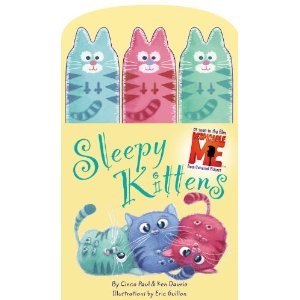 The best part of the movie Despicable Me, for my money anyway, is when Gru reads a bedtime story to Margo, Edith, and Agnes, the three little girls he's adopted to help him infiltrate his nemesis Vector's lair. The book he reads--at Agnes's insistence--is called Sleepy Kittens; it's a novelty book featuring three kitten finger puppets who drink their milk, brush their fur, you get the idea. Gru is disgusted: "This is garbage! You like this?" (Of course they do.) I think he even suggests that a two-year-old could have written it. I'm sure a lot of parents have thought they could do better when it comes to their kids' books, too. It's harder than it looks.
The best part of the movie Despicable Me, for my money anyway, is when Gru reads a bedtime story to Margo, Edith, and Agnes, the three little girls he's adopted to help him infiltrate his nemesis Vector's lair. The book he reads--at Agnes's insistence--is called Sleepy Kittens; it's a novelty book featuring three kitten finger puppets who drink their milk, brush their fur, you get the idea. Gru is disgusted: "This is garbage! You like this?" (Of course they do.) I think he even suggests that a two-year-old could have written it. I'm sure a lot of parents have thought they could do better when it comes to their kids' books, too. It's harder than it looks.
Anyway, the smart merchandising folks at Universal published Sleepy Kittens as a movie tie-in, finger puppets and all. Apparently the actual book is not as good as the one in the movie, in a sort of meta-reversal of people's usual complaints, but it's a clever idea nonetheless.
[And one that the people who made Michael Clayton missed out on completely. My post on the middle-grade fantasy novel featured in that movie, Realm+Conquest, consistently gets more hits than anything else I've written here, and despite the fact that Realm+Conquest is not a real book, people continue to ask me where they can get it. Someone please write that book already!]
Back to Despicable Me. Later in the movie, Gru reads the girls a book he's written just for them, The Lonely Unicorn. He should probably stick to his day job, but the girls love it. (Of course they do.) Have you seen the movie? Did you?





